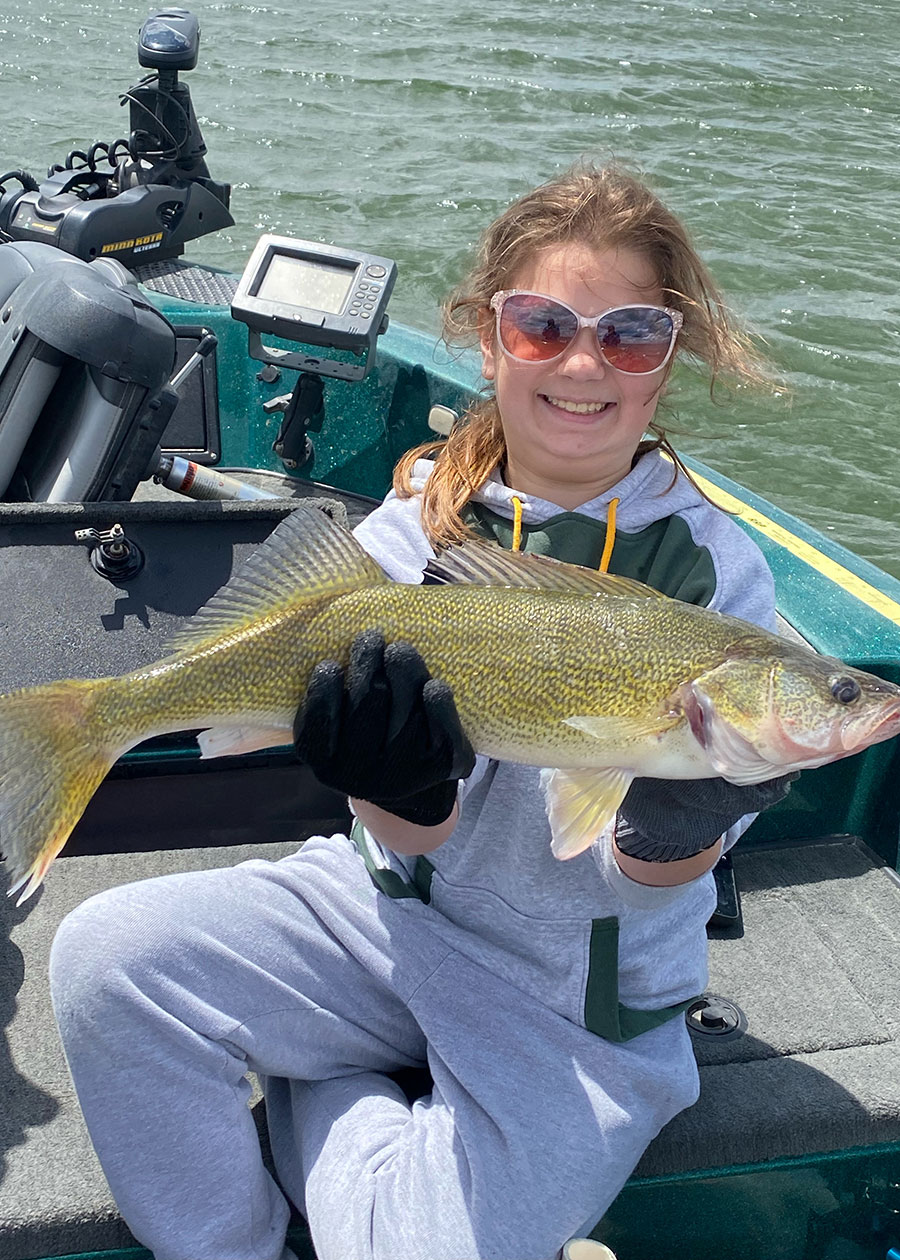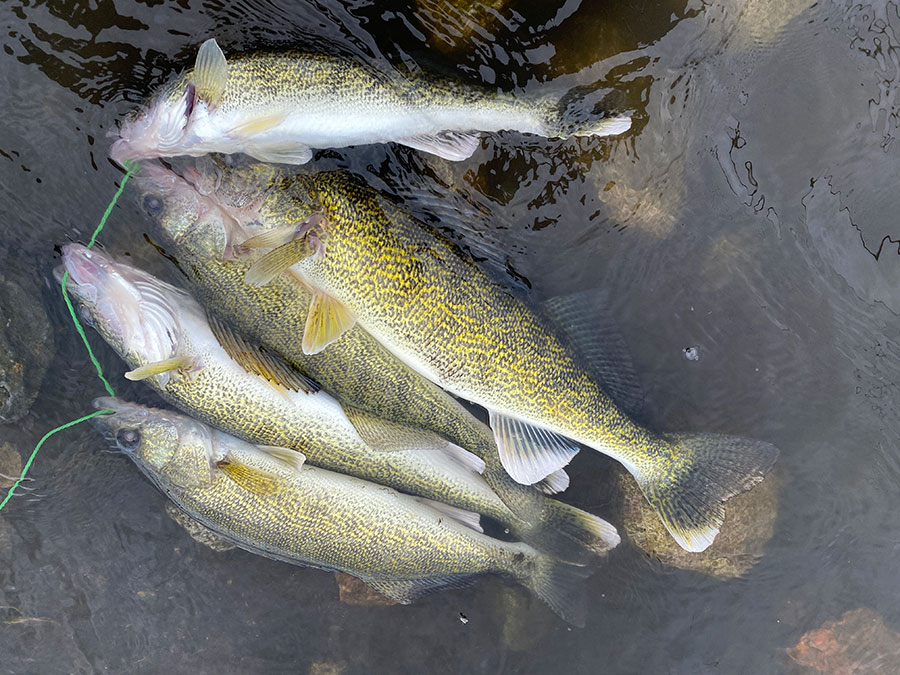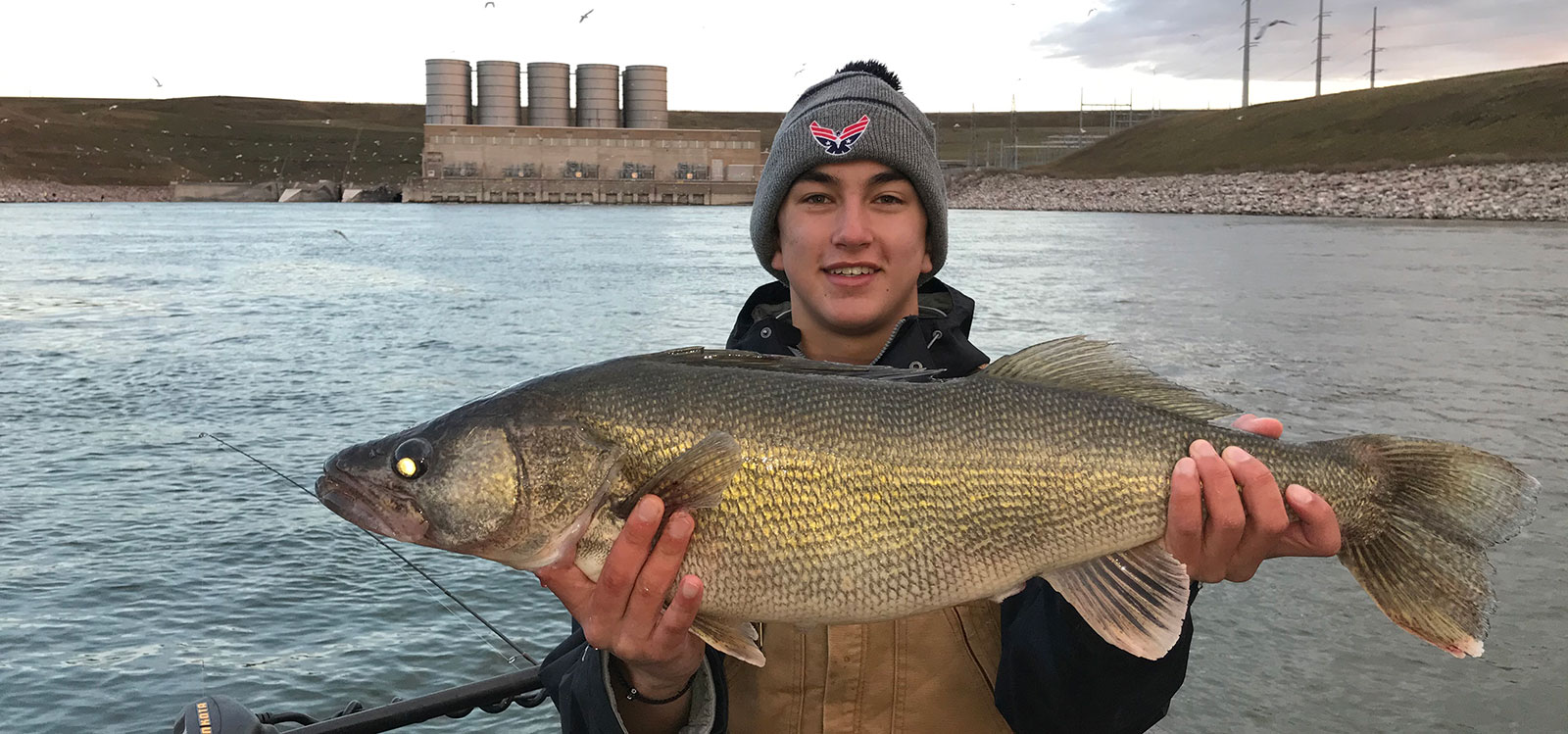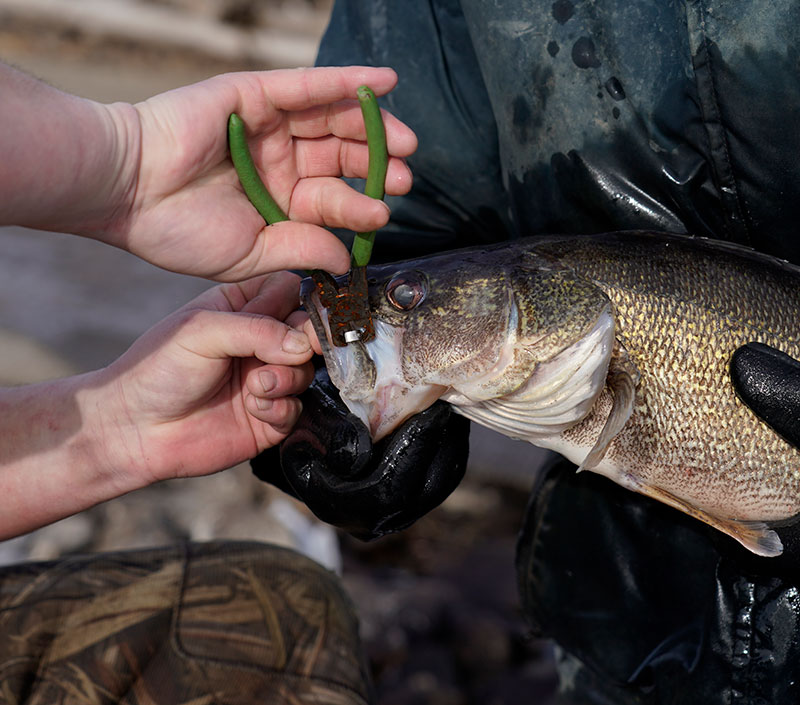Big Walleye Bite
SC Fisheries Management Supervisor Paul Bailey

Angling for walleye is a year-round pursuit for many and we’re fortunate our state provides the opportunity to land a fish for a photo or the frying pan no matter the date on the calendar.
Die-hard anglers have likely noticed that the sizes of walleye they encounter change in a predictable pattern throughout the year whether they are fishing on the Missouri River System, Devils Lake, or one of our numerous prairie lakes. This pattern and the reasons for it have been the subject of many boat or beach conversations with plausible explanations ranging from “anglers harvested all the females in the spring,” “the big fish hide in the weeds during summer,” “egg-laden females bite better right before the spawn,” “the large fish migrate downstream every summer,” “the big girls strap on the feedbag in fall,” to “little fish bite better when the water is warmest.”
As one of North America’s premier sportfish, walleye have been extensively studied by fisheries scientists and a wealth of biological information exists for this species. The North Dakota Game and Fish Department has also conducted numerous tagging studies that support or dispel the statements above.
So, what is fact and what is fiction?
Prairie Lake Example
First, let’s take a look at the tagged walleye anglers reported catching in Alkaline Lake in Kidder County during the 2019-20 tagging study to see if there really are seasonal differences in the sizes of fish anglers are catching.
The Department tagged 1,995 walleye during this study, all of which were at least 13 inches long and the longest was 28.7 inches. These 1,995 tagged fish averaged 18.5 inches, but at certain times of the year, the average lengths of tagged walleye anglers reported catching were above or below 18.5 inches.
For example, the average size of tagged walleye reported by anglers was greatest during April-May (20.3 inches) followed by October-December (19.4 inches). Whereas the average length of tagged walleye reported by anglers in July, August and September were much lower at 17.6 inches, 17.4 inches and 17.0 inches, respectively.

So, the Alkaline tagging study confirms the existence of a seasonal pattern in the sizes of walleye that anglers are likely to reel in. But why does this pattern exist?
The seasonal differences anglers see in the sizes of walleye they catch are the result of two primary factors: water temperature and hormones.
Let’s start with temperature. Walleye are cold-blooded animals whose body temperature is determined by the temperature of the water around them. As such, water temperature has an enormous effect on virtually all aspects of a walleye’s life including their metabolic rate, how fast they grow, when they reproduce, how often they feed, and how fast they digest what they eat.
Interestingly, walleye of different ages and sizes have different preferred temperatures for feeding and converting that food into growth in size or reproductive organs.
And, you guessed it, walleye are more likely to eat an angler’s bait when temperatures are closer to optimal for that particular size of fish to feed. From the time they hatch through their first year of age, walleye prefer warmer temperatures of around 72 degrees. Juvenile walleye (typically 8- to 15-inch fish) prefer intermediate water temperatures of approximately 64-72 degrees, and adult fish exhibit the greatest feeding and food conversion efficiency when water temperatures are in the low to mid-60s.
This relationship between walleye size and preferred feeding temperature partially explains the seasonal pattern in the sizes of walleye anglers catch in Alkaline Lake and many other lakes. Anglers are more likely to encounter larger walleye during spring and fall when water temperatures are closer to optimal for large (adult) walleye to feed. Smaller fish, on the other hand, are more likely to feed and cooperate with anglers when water temperatures are at their warmest in July through September.
Hormones also influence walleye feeding and how well fish cooperate with anglers. In the Percid family of fishes, of which walleye, sauger and yellow perch are prominent members, male and female hormones have the opposite effect on appetite. The walleye version of estrogen (the female reproductive hormone) enhances appetite when levels are increased. Estrogen levels are highest in female walleye as egg development begins in response to shortening day length (photoperiod) in late October and remain elevated through spawning.
The observation by many astute anglers that female walleye “strap on the feedbag” in fall is an accurate one. Levels of appetite enhancing estrogen in female walleye drastically drop following the spring spawn and remain low until the cycle repeats itself the following fall. This annual estrogen cycle enhances the likelihood of female walleye cooperating with anglers from fall through spring.
Alternately, the walleye version of testosterone (the male reproductive hormone) acts as an appetite suppressant. Testosterone levels increase as gamete production begins in fall, remain elevated through the spring spawn, and then drop to low levels throughout summer. The lower levels of appetite suppressing testosterone in summer increases the likelihood of a male walleye biting your lure during this time.
Indeed, looking at data from the Alkaline Lake tagging study illustrates the impact of male and female hormones on when female walleye (which tend to be larger fish) and males (which tend to be smaller fish) are more likely to be caught by anglers. Sexually mature female walleye represented 30% of all walleye tagged at Alkaline Lake. However, sexually mature female walleye composed 44% of the fish anglers caught from fall through the spring spawn due to the influence of elevated appetite enhancing estrogen. Female walleye only composed 27% of the fish anglers caught during summer due to the absence of both appetite enhancing estrogen in females and appetite suppressing testosterone in males.
The opposite effects of male and female reproductive hormones on appetite also helps to explain why a high proportion of yellow perch caught by ice anglers are females with developing eggs.
Seasonal fluctuations in water temperature and hormone levels work together to influence the sizes of walleye more likely to cooperate with anglers at various times of the year. This certainly doesn’t mean an angler can’t land a whopper in August or that an 11-inch fish won’t be a nuisance in April, but it does mean that the probability of either of those things happening is reduced at those times of the year.
While water temperature and hormones are important factors, forage availability may also impact the number and sizes of fish anglers are catching in different habitats. For example, I was fishing the Logan Wildlife Management Area in Logan County late in the summer a decade or so ago and leopard frogs were littering the shoreline. Walleye large enough to swallow these frogs were feeding in 3-5 feet of water in stands of shoreline vegetation where frogs were most abundant. This led to outstanding fishing while pitching swimbaits in the shallows for some of the largest fish that the lake had to offer. Fishing Logan WMA’s deeper areas at this time tended to produce smaller fish with bellies full of caddisflies. Similar size segregations may occur during spawning as mature walleye concentrate within shallow spawning habitats while immature fish generally remain in deeper areas.

The Missouri River System
Water temperature and hormones also influence the sizes of walleye anglers catch on the Missouri River System. For example, as ice leaves the Missouri River and Lake Oahe fishery each spring the warmest water is typically found in Lake Oahe’s headwaters near the Hazelton and Fort Rice areas. This is due to the deep, cold-water releases from Garrison Dam warming as they flow downstream, coupled with Lake Oahe taking longer to warm as its depth increases in downstream reaches.
It is no coincidence that Lake Oahe’s headwaters offer some of the best springtime walleye fishing in the region. While April water temperatures may be cool, they are closer to optimal for larger adult fish to feed than small fish, and females still have an enhanced appetite due to elevated estrogen levels that can lead to great fishing for larger fish.
As water temperatures warm towards optimal levels in both an upstream direction towards Garrison Dam and downstream towards Oahe Dam, the best fishing tends to progress in those directions as well. This leads to the best fishing (and anglers following that fishing) to move both upstream and downstream from the Hazelton and Fort Rice areas as spring progresses. Small fish tend to dominate angler catches during summer due to above optimal temperatures for large walleye feeding and hormonal influences. Then, as fall returns, large fish are more likely to appear on the end of your line as temperatures decline and female fish regain their appetite.
So, how do we know if walleye are moving in an upstream or downstream direction in the Missouri River and Lake Oahe fishery along with these water temperatures or if are they staying put? Past tagging studies provide the answer.
During the 2013 through 2016 Missouri River and Lake Oahe walleye tagging study, fisheries personnel with the North Dakota Game and Fish Department, South Dakota Game, Fish and Parks, and South Dakota State University tagged over 34,000 walleye between Garrison and Oahe dams. Anglers have since reported catching nearly 9,000 of these fish, which allows us to draw some conclusions regarding walleye movements throughout this system.
A small portion of the walleye tagged between Garrison and Oahe dams did move some impressive distances, up to nearly 300 miles from the Garrison Dam spillway channel to areas just upstream of Oahe Dam. However, those types of movements were far from typical. More often tagged fish that anglers reported to us moved very little from the location where they were tagged. For example, approximately half of the fish anglers reported were caught within 10 miles of where they were tagged and 90% of fish were caught within 20 miles of where they were tagged.
That pattern holds true for the large female walleye that we tagged as well. Most of the female walleye that anglers reported catching were caught in relatively close proximity to the location where they were tagged. Additionally, the Department conducts annual nighttime electrofishing surveys of the Missouri River near July 4 and an annual netting survey of Lake Oahe in mid-July and we routinely see large female walleye during these sampling events.
For example, we sampled a 28-inch walleye near the Fox Island boat ramp and a 29.5-inch walleye near Ft. Yates during our July 2022 sampling. Our sampling tells us that large female walleye are still present throughout this fishery in July even though I, and many other anglers, are less likely to encounter one of these large fish on the end on our line during this time.
While walleye in the Missouri River System generally do not move very far, that does not mean they don’t move at all. Walleye seek out different habitat types to best meet their needs at different times of the year.

